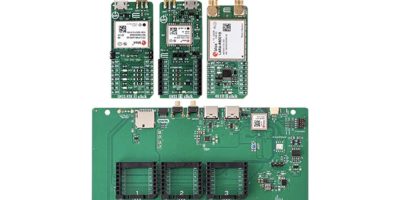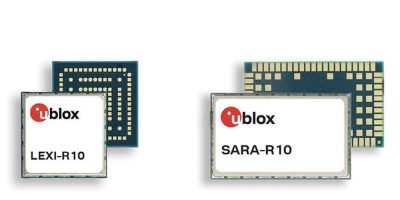GOWIN Semiconductor has launched the GW5AT-15 FPGA to provide a programmable high-speed bridging solution for demanding consumer electronics and automotive use cases such as 4K video transfer at high frame rates up to 120 frames/s.
The new GW5AT-15, the latest member of the Arora-V FPGA family, combines various hard-core SerDes transceivers with high-speed memory and 15,120 logic elements. The product is available in package options including a compact 4.9mm x 5.3mm WLCSP, which offers maximum SerDes throughput of 12.5Gbps.
The features of the GW5AT-15 are ideal for an emerging set of use cases which call for very high bandwidth for video and other data-transfer applications, and which require a small board footprint – examples include consumer tablets, augmented/virtual reality headsets, and car infotainment systems.
The high SerDes bandwidth offered by the GW5AT-15 makes it ideal for use in high-speed interfaces. This new FPGA features:
• 3-lane MIPI C-PHY operating at up to 5.75Gbps/lane
• 4-lane PCIe 3.0
• 4-lane MIPI D-PHY operating at up to 2.5Gbps/lane
The GW5AT-15 also supports high-speed USB Type-C and other USB connections with its on-chip USB 3.x and USB 2.x PHYs.
The high throughput offered by the GW5AT-15 supports gamers’ requirement for high frame-rate 4K video in the latest consumer tablet designs. In vehicle infotainment systems, the GW5AT-15’s provision of high-speed USB and other interfaces enables cars to better emulate the smartphone user experience through applications such as the Android Auto or Apple CarPlay software companions.
All SerDes operations are backed by co-packaged fast memory resources including:
• 118kb of shadow SRAM
• 630kb of block SRAM (BSRAM) arranged as 35 x 18kb
• Optional 64Mb (in MG132P package) or 128Mb (in CM90P package) of pseudo SRAM (pSRAM)
• Optional 8Mb of NOR Flash
The FPGA also features two on-chip PLLs, multiple clock sources, a JPEG codec, and an ADC.
Like the other members of the Arora-V family, the GW5AT-15 is built on a low-power 22nm TSMC process. It is backed by the GOWIN EDA FPGA design environment, which includes an FPGA design tool, IP cores and reference designs. The FPGA design tool supports the SystemVerilog, Verilog and VHDL programming languages.
Latest News
Now at Mouser u-blox explorer kit for rapid development of high precision GNSS applications
Mouser is now shipping the XPLR-HPG-1 Explorer kit from u-blox. This Explorer kit is comprised of a baseboard populated with a NORA-W106 module, which integrates a powerful dual-core 32-bit microcontroller with 802.11b/g/n Wi-Fi and dual-mode Bluetooth LE 5 connectivity. The baseboard also features three mikroBUS connectors with pre-mounted click boards hosting u-blox positioning and cellular modules. The GNSS RTK 2 click board features the ZED-F9R module, a high-precision dead-reckoning. The LBAND RTK click board includes the NEO-D9S module, a satellite data receiver for the L-band correction broadcast. The 4G LTE 2 click board features the LARA-R6001D, a compact LTE Cat 1 multi-mode module offering global coverage, enabling the reception of PointPerfect correction data via mobile networks. Equipped with its GNSS and communication modules, this Explorer kit can access correction data from a satellite broadcast via L-band satellite GNSS receiver or IP connectivity using LTE or Wi-Fi. PointPerfect, the u-blox GNSS augmentation service, provides correction data delivered via the Thingstream IoT service delivery platform. The XPLR-HPG-1 also supports the Networked Transport of RTCM via Internet Protocol (NTRIP. The XPLR-HPG-1 kit’s modular design also enables users to switch out Mikroe click boards. The Explorer kit provides a flexible, modular development and prototyping platform for centimetre-level accuracy positioning applications, such as autonomous robotics, asset tracking and connected health.
Alif launches an MCU with AI/ML processing in a tiny footprint
Alif Semiconductor has launched the Ensemble E1C, an MCU series which combines rich digital and analog capabilities with a low-power on-chip neural processing unit (NPU) in a new compact form factor.
This new Ensemble family MCU, which combines a 160MHz Arm Cortex-M55 CPU core with Helium vector processing extension, an Arm Ethos-U55 NPU generating up to 46 GOPs, and up to 2MB of tightly coupled SRAM, is available in a tiny WLCSP package occupying a footprint of 3.9mm x 3.9mm.
The introduction of the E1C extends the Ensemble family, providing a new entry-level option for OEMs that want AI performance and ultra-low power consumption implemented in a familiar Arm environment. The new E1C also shares the same architecture as the Balletto family, allowing for software re-use across the entire family, and easy migration of applications from one device to another.
The E1C can perform both AI/ML and application control functions at ultra-low power levels. This means manufacturers can bring advanced ML capabilities to products such as wearable devices that have extreme constraints on power and space. The E1C’s capabilities are optimised for local ML workloads such as object recognition, speech recognition, sensor fusion, and adaptive audio noise cancellation, easing heavy dependence on the cloud to provide a better user experience.
The high AI performance of the E1C is matched by its power efficiency. The E1C’s aiPM technology can dynamically power only the logic and associated memory that are in use at any given time, thus achieving the lowest overall system power consumption. The aiPM power management unit implements four system-level power modes including a Stop mode which draws just 700nA.
The Ethos-U55 NPU performs 128 MACs/cycle to give ML output of 46 GOPS, and enables on-the-fly weight decompression. This results in inferencing performance some 100x faster and more power-efficient than competing MCUs based on an Arm Cortex-M4 CPU provide. The E1C’s digital cores are backed by up to 2MB of MRAM non-volatile memory alongside up to 2MB of zero wait-state SRAM. A high-speed OctalSPI interface enables expansion to external memory if required. Versions of E1C devices are offered with and without the NPU.
The E1C features a rich set of analog and connectivity peripherals. Two 12-bit SAR ADCs and a 24-bit sigma-delta ADC, a 12-bit DAC and an internal reference voltage provide for fast, precise processing of signals from external sensors. Outputs can be displayed on rich colour displays using a MIPI DSI display interface.
A broad selection of serial communications interfaces includes USB 2.0, SDIO, 2x CAN FD and I3C. Designers of connected devices can also benefit from the same low-power and high-performance characteristics of the E1C with the addition of built-in Bluetooth Low Energy connectivity by choosing the Balletto B1, launched by Alif on 9 April 2024.
Security is a core attribute of the Ensemble family, and the E1C shares the same architecture. Its advanced secure enclave, which provides a solid hardware root-of-trust enabling secure key generation and storage, secure boot, cryptographic accelerators, and certificate management, eliminates the need for an external Secure MCU in endpoint AI devices.
u-blox announces new ultra-compact LTE Cat 1bis cellular modules
u-blox has announced an expansion to its range of R10 products for the fast-growing LTE Cat 1bis cellular connectivity market. Predicted by analyst firm Techno Systems Research Co., Ltd to account for 43.6% of all non-handset cellular devices by 2029, LTE Cat 1bis is expected to be the best-selling cellular technology for the Internet of Things (IoT) for the next four to five years.
About Weartech
This news story is brought to you by weartechdesign.com, the specialist site dedicated to delivering information about what’s new in the wearable electronics industry, with daily news updates, new products and industry news. To stay up-to-date, register to receive our weekly newsletters and keep yourself informed on the latest technology news and new products from around the globe. Simply click this link to register here: weartechdesign.com







